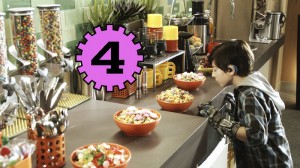
In this film image released by The Weinstein Co., Mason Cook is shown in a scene from "Spy Kids: All the Time in the World in 4D." Filmmaker Robert Rodriguez is using "Aroma-Scope," to add scents to the new “Spy Kids.” Viewers are given scratch-and-sniff cards with circles numbered 1 to 8. When a number appears on screen, they rub the corresponding circle on their cards, which give off a whiff matching what the characters are smelling. AP
LOS ANGELES—Robert Rodriguez deliberately tried to make his latest “Spy Kids” adventure a bit of a stinker.
Rodriguez, who helped usher in the new age of 3-D movies with the franchise’s third installment in 2003, is billing “Spy Kids: All the Time in the World” as a 4-D flick, adding scent cards so audiences can follow along on the action with their noses.
Here’s how it works: Viewers are given scratch-and-sniff cards with circles numbered 1 to 8. When a number appears on screen, they rub the corresponding circle on their cards, which give off a whiff matching what the characters are smelling.
Rodriguez calls his gimmick “Aroma-Scope.” He tried it out at test screenings and found that children and parents had a good time with it.
“When it came time to do ‘Spy Kids 4,’ I couldn’t just go back and do 3-D like everybody else is now. I had to bring something extra,” Rodriguez said. “Just watching my own kids with interactive gaming, you ask them to watch a movie, it just feels so passive to them. I thought, this helps bridge the gap. It’s an interactive thing, almost like playing a game while you’re watching the movie.”
The idea dates back to John Waters’ 1981 suburban satire “Polyester,” released in “Odorama,” with viewers given similar scratch-and-sniff cards. The 2003 animated tale “Rugrats Go Wild” also used cards to add scent to the picture.
The new “Spy Kids,” opening Friday and playing in both 2-D and 3-D versions, uses its odors (offered in both formats) to complement the story as a retired operative (Jessica Alba) is called back to service to fight a villain who has speeded up time, threatening to bring about a quick end to the world.
She’s kept her vocation a secret from her new husband (Joel McHale), but her step-kids (Rowan Blanchard and Mason Cook) wind up pressed into the action, aided by the now grown-up original spy kids (Alexa Vega and Daryl Sabara) from the first three movies.
The smells from the scratch-and-sniff cards are mostly pleasant. However, with a bit of raunchy humor, including gags about a spy baby’s diapers, viewers should expect at least one off odor.
“Originally, we didn’t have any really rancid smells, but kids wanted something really stinky in there,” Rodriguez said. “It really doesn’t smell that bad. No one’s going to get sick in the theater.”
Rodriguez’s Aroma-Scope follows a long tradition of adding something extra to the movies.
Filmmakers began trying gimmicks to hang onto audiences as television eroded movie attendance in the late 1940s and early 1950s. Most were short-lived or one-time tricks, such as early tries at 3-D cinema or such odor-adding processes as Smell-O-Vision, in which scents were piped into theaters.
Producer William Castle (“13 Ghosts,” ”House on Haunted Hill”) was a P.T. Barnum of cinema showmanship in the ’50s, ’60s and ’70s, offering life insurance for any viewers that died of fright and rigging theaters with a glow-in-the-dark skeleton that swung above the crowd.
“Earthquake” and a few other ’70s movies were released in “Sensurround,” which used low-frequency bass sound to rattle audiences during scenes of tremors or high action.
And looking ahead, there’s been industry buzz about equipping theaters with advanced “3-D” audio systems that would create the effect of sound that seems as if it’s moving completely around a viewer.
For now, though, Rodriguez has no plans to venture beyond his 4-D scratch-and-sniff filmmaking and might consider doing it again on a movie down the road.
“Watching the kids do it is the best part. Just seeing them so glued to the screen as if they’ve been doing it all their lives,” Rodriguez said. “Plus it’s a souvenir they can take home.”